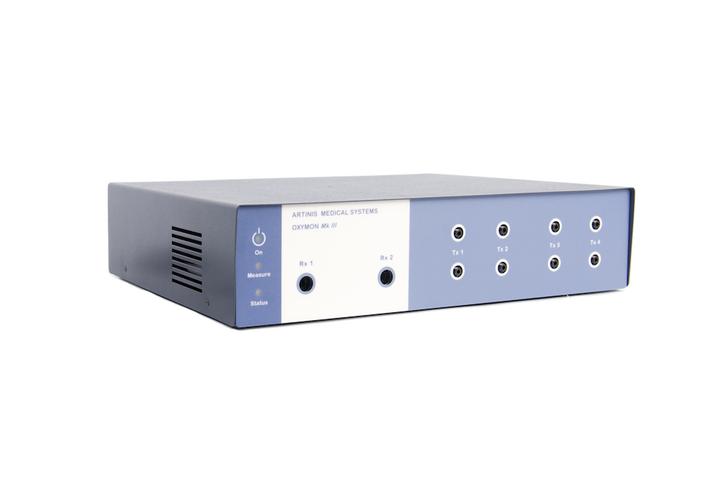
Publications using the OxyMon
NIRS-EEG joint imaging during transcranial direct current stimulation: Online parameter estimation with an autoregressive model
Background Transcranial direct current stimulation (tDCS) has been shown to perturb both cortical neural activity and hemodynamics during (online) and after the stimulation, however mechanisms of these tDCS-induced online and after-effects are not …
Transcranial direct current stimulation improves isometric time to exhaustion of the knee extensors
Transcranial direct current stimulation (tDCS) can increase cortical excitability of a targeted brain area, which may affect endurance exercise performance. However, optimal electrode placement for tDCS remains unclear. We tested the effect of two …
T2-prepared velocity selective labelling: A novel idea for full-brain mapping of oxygen saturation
Background and aim: Disturbances in cerebral oxygenation saturation (SO2) have been linked to adverse outcome in adults, children, and neonates. In intensive care, the cerebral SO2 is increasingly being monitored by Near-InfraRed Spectroscopy (NIRS). …
Physiological characteristics of elite high-altitude climbers
Factors underlying the amplitude of exercise performance reduction at altitude and the development of high-altitude illnesses are not completely understood. To better describe these mechanisms, we assessed cardiorespiratory and tissue oxygenation …
Near-infrared spectroscopy - electroencephalography-based brain-state-dependent electrotherapy: A computational approach based on excitation-inhibition balance hypothesis
Stroke is the leading cause of severe chronic disability and the second cause of death worldwide with 15 million new cases and 50 million stroke survivors. The poststroke chronic disability may be ameliorated with early neuro rehabilitation where …
Vigilance task-related change in brain functional connectivity as revealed by wavelet phase coherence analysis of near-infrared spectroscopy signals
This study aims to assess the vigilance task-related change in connectivity in healthy adults using wavelet phase coherence (WPCO) analysis of near-infrared spectroscopy signals (NIRS). NIRS is a non-invasive neuroimaging technique for assessing …
Prefrontal Cortex Activation while Walking under Dual-Task Conditions in Stroke
Background. Walking while performing another task (eg, talking) is challenging for many stroke survivors, yet its neural basis are not fully understood. Objective. To investigate prefrontal cortex activation and its relationship to gait measures …
A novel semi-immersive virtual reality visuo-motor task activates ventrolateral prefrontal cortex: A functional near-infrared spectroscopy study
Objective. In the last few years, the interest in applying virtual reality systems for neurorehabilitation is increasing. Their compatibility with neuroimaging techniques, such as functional near-infrared spectroscopy (fNIRS), allows for the …
Oxygenation, local muscle oxygen consumption and joint specific power in cycling: the effect of cadence at a constant external work rate
Purpose: The present study investigates the effect of cadence on joint specific power and oxygenation and local muscle oxygen consumption in the vastus lateralis and vastus medialis in addition to the relationship between joint specific power and …
Cerebral Hemodynamics During Exercise and Recovery in Heart Transplant Recipients
Background: The aims of this work were (1) to compare cerebral oxygenation-perfusion (COP), central hemodynamics, and peak oxygen uptake (V˙o2peak) in heart transplant recipients (HTRs) vs age-matched healthy controls (AMHCs) during exercise and …
Effects of sprint interval cycling on fatigue, energy, and cerebral oxygenation
Introduction Feelings of fatigue are reduced after a session of continuous exercise of low-to-moderate intensity lasting 20 min or more, but only when feelings of energy are increased. Feelings of fatigue and energy have not been described after …
Measuring reactive hyperemia in the lower limb using near-infrared spectroscopy
Near-infrared spectroscopy (NIRS) has been used to measure reactive hyperemia following a vascular occlusion. However, the procedures and methods of analysis used have varied. The purpose of the present study is to identify reproducible methods for …
Exercise oxidative skeletal muscle metabolism in adolescents with cystic fibrosis
Patients with cystic fibrosis (CF) are reported to have limited exercise capacity. There is no consensus about a possible abnormality in skeletal muscle oxidative metabolism in CF. Our aim was to test the hypothesis that abnormalities in oxygenation …
Local muscle oxygen consumption related to external and joint specific power
The purpose of the present study was to examine the effects of external work rate on joint specific power and the relationship between knee extension power and vastus lateralis muscle oxygen consumption (mVO2). We measured kinematics and pedal forces …
Acute cocoa flavanol improves cerebral oxygenation without enhancing executive function at rest or after exercise
Acute exercise-induced improvements in cognitive function are accompanied by increased (cerebral) blood flow and increased brain-derived neurotrophic factor (BDNF) levels. Acute cocoa flavanol (CF) intake may improve cognitive function, cerebral …
Effect of acute hypoxia on inspiratory muscle oxygenation during incremental inspiratory loading in healthy adults
Purpose: To non-invasively examine the effect of acute hypoxia and inspiratory threshold loading (ITL) on inspiratory muscles [sternocleidomastoid (SCM), scalene (SA) and parasternal (PS)] oxygenation in healthy adults using near-infrared …
Effective Connectivity of Cortical Sensorimotor Networks During Finger Movement Tasks: A Simultaneous fNIRS, fMRI, EEG Study
Recently, interest has been growing to understand the underlying dynamic directional relationship between simultaneously activated regions of the brain during motor task performance. Such directionality analysis (or effective connectivity analysis), …
Effects of anodal high-definition transcranial direct current stimulation on bilateral sensorimotor cortex activation during sequential finger movements: An fnirs study
Transcranial direct current stimulation (tDCS) is a non-invasive electrical brain stimulation technique that can modulate cortical neuronal excitability and activity. This study utilized functional near infrared spectroscopy (fNIRS) neuroimaging to …
High-intensity Interval training enhances mobilization/functionality of endothelial progenitor cells and depressed shedding of vascular endothelial cells undergoing hypoxia
Purpose: Exercise training improves endothelium-dependent vasodilation, whereas hypoxic stress causes vascular endothelial dysfunction. Monocyte-derived endothelial progenitor cells (Mon-EPCs) contribute to vascular repair process by differentiating …
Improving peripheral and central vascular adjustments during exercise through a training program in adolescents with obesity
Objective: The effects of a training program (TP) on muscle microvascularization during exercise remained to be explored in adolescents with obesity. We hypothesized that a TP would lead to better microvascular adaptations to exercise in skeletal …